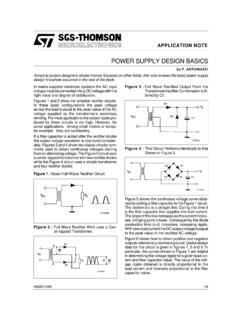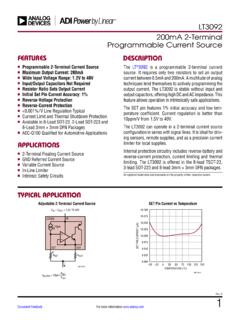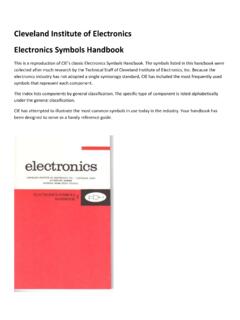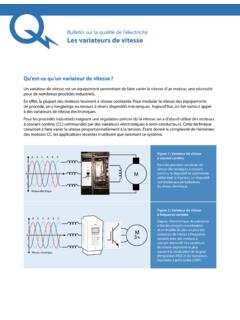Transcription of MULTIPLE CHOICE QUESTIONS - AE
1 MULTIPLE CHOICE QUESTIONS - AE On Rectifiers and Filters: 1. In a half wave rectifier, the load current flows for what part of the cycle. a. 400 b. 900 c. 1800 d. 3600 2. In a full wave rectifier, the current in each diode flows for a. whole cycle of the input signal b. half cycle of the input signal c. more than half cycle of the input signal d. none of these 3. in a full wave rectifier, if the input frequency is 50 Hz, then output frequency will be a. 50 Hz b. 75 Hz c. 100 Hz d. 200 Hz 4. In a center tap full wave rectifier, if Vm is the peak voltage between center tap and one end of the secondary, the maximum voltage coming across the reverse bias diode is a. Vm b. 2 Vm c. Vm/2 d. Vm/ 2 5. The maximum efficiency of full wave rectification is a.
2 B. 100% c. d. 6. In a bridge type full wave rectifier, if Vm is the peak voltage across the secondary of the transformer, the maximum voltage coming across each reverse biased diode is a. Vm b. 2 Vm c. Vm/2 d. Vm/ 2 7. To get a peak load voltage of 40V out of a bridge rectifier. What is the approximate rms value of secondary voltage? a. 0 V b. V c. V d. V 8. If the line frequency is 50 Hz, the output frequency of bridge rectifier is a. 25 Hz b. 50 Hz c. 100 Hz d. 200 Hz 9. The ripple factor of a bridge rectifier is a. b. c. d. 10. The bridge rectifier is preferred to an ordinary two diode full wave rectifier because a. it needs much smaller transformer for the same output b. no center tap required c. less PIV rating per diode d.
3 All the above 11. The basic purpose of filter is to a. minimize variations in ac input signal b. suppress harmonics in rectified output c. remove ripples from the rectified output d. stabilize dc output voltage 12. The use of a capacitor filter in a rectifier circuit gives satisfactory performance only when the load a. current is high b. current is low c. voltage is high d. voltage is low 13. A half wave rectifier is equivalent to a. clamper circuit b. a clipper circuit c. a clamper circuit with negative bias d. a clamper circuit with positive bias 14. The basic reason why a full wave rectifier has a twice the efficiency of a half wave rectifier is that a. it makes use of transformer b. its ripple factor is much less c. it utilizes both half-cycle of the input d.
4 Its output frequency is double the line frequency 15. In a rectifier, larger the value of shunt capacitor filter a. larger the peak-to-peak value of ripple voltage b. larger the peak current in the rectifying diode c. longer the time that current pulse flows through the diode d. smaller the dc voltage across the load 16. In a LC filter, the ripple factor, a. Increases with the load current b. increases with the load resistance c. remains constant with the load current d. has the lowest value 17. The main reason why a bleeder resistor is used in a dc power supply is that it a. keeps the supply ON b. improves voltage regulation c. improves filtering action d. both (b) and (c) 18. Which rectifier requires four diodes? a. half-wave voltage doubler b. full-wave voltage doubler c.
5 Full-wave bridge circuit d. voltage quadrupler Answers 1. (c) 2. (b) 3. (c) 4. (b) 5. (c) 6. (a) 7. (c) 8. (c) 9. (a) 10. (d) 11. (c) 12. (b) 13. (b) 14. (c) 15. (b) 16. (c) 17. (d) 18. (c) ON BJT: 1. In CE configuration the output V- I characteristics are drawn by taking (a) VCE vs. IC for constant value of IE (b) VCE vs. IC for constant value of IB (c) VCE vs. IC for constant value of VCB (d) None of these 2. In CE configuration the input V-I characteristics are drawn by taking (a) VCE vs. IC for constant value of IE (b) VBE vs. IE for constant value of VCE (c) VBE vs. IB for constant value of IC (d) VBE vs. IB for constant value of VCB 3. The transistor is said to be in quiescent state when (a) it is unbiased (b) no current flows through it (c) no signal is applied to the input (d) emitter junction is just biased equal to collector junction 4.
6 In CB configuration, the output V- I characteristics of the transistor are drawn by taking (a) VCB vs. IC for constant IE (b) VCB vs. IB for constant IE (c) VCB vs. IC for constant IE (d) VCB vs. IB for constant IE 5. When the collector junction in a transistor is biased in reverse direction and the emitter junction in the forward direction, the transistor is said to be is the (a) active region (b) cutoff region (c) saturation (d) none of them 6. To avoid thermal runaway in the design of analog circuits, the operating point of the BJT should be such that it satisfies the condition (a) (b) (c) (d) 7. Thermal runaway will take place if the quiescent point is such that (a) (b) (c) (d) (UPSC Engg. Service 1999) 8. The power dissipated by a transistor approximately equals the collector current times (a) base emitter voltage (b) collector emitter voltage (c) base supply voltage (d) 9.
7 Leakage current in CE configuration is (a) very high (b) very small (c) normal (d) not present 10. The dc current gain in common collector configuration is given by (a) (b) (c) + 1 (d) + 1 11. The leakage current ICBO flows in (a) The emitter, base and collector leads (b) The emitter and base leads. (c) The emitter and collector leads. (d) The base and collector leads. 12. Early effect in BJT refers to (a) avalanche breakdown (b) thermal breakdown (c) base narrowing (d) Zener breakdown 13. The emitter of the transistor is generally doped the heaviest because it (a) has to dissipate maximum power (b) has to supply the charge carriers (c) is the first region of transistor (d) must possess low resistance 14. In a properly Biased NPN transistor most of the electrons from the emitter (a) recombine with holes in the base (b) recombine in the emitter its self (c) pass through the base to the collector (d) are stopped by the junction barrier 15.
8 In a transistor amplifier, the reverse saturation current ICO (a) double for every 100 rise in temperature (b) doubles for every 10 rise in temperature (c) increase linearly with the temperature (d) doubles for every 50 rise in temperature 16. The collector characteristics of a common- emitter connected transistor may be used to find its (a) input resistance (b) base current (c) output resistance (d) voltage gain 17. Which of the following transistor configuration circuit is much less temperature dependent (a) common base (b) common emitter (c) common collector (d) none of the above 18. The CE amplifier circuit are preferred over CB amplifier circuit because they have (a) lower amplification factor (b) larger amplification factor (c) high input resistance and low output resistance (d) none of these 19.
9 A transistor when connected in CE mode has (a) a low input resistance and a low output resistance (b) a high input resistance and high output resistance (c) a high input resistance and low output resistance (d) a medium input resistance and high output resistance 20. A transistor connected in common base configuration has (a) a high input resistance and low output resistance (b) a low input resistance and high output resistance (c) a low input resistance and low output resistance (d) a high input resistance and a high output resistance Answers 1. (b) 2. (d) 3. (c) 4. (a) 5. (a) 6. (c) 7. (d) 8. (b) 9. (a) 10. (c) 11. (d) 12. (c) 13. (b) 14. (c) 15. (a) 16. (c) 17. (c) 18. (b) 19. (d) 20. (b) diode Clippers, Clampers & Voltage Multipliers 1.
10 A circuit that removes positive or negative parts of waveform is called a. clamper b. clipper c. diode clamp d. limiter 2. A circuit that adds positive or negative dc voltage to an input sine wave is called a. clamper b. clipper c. diode clamp d. limiter 3. Voltage multipliers are circuits best used to produce a. low voltage and low current b. low voltage and high current c. high voltage and low current d. high voltage and high current 4. Half wave voltage multiplier can provide any degree of voltage multiplication by cascading diodes and capacitors. a. only doubler b. only tripler c. any multiplication d. none of the above 5. Consider the following statements:A clamper circuit 1. adds or subtracts a dc voltage to a waveform 2. does not change the waveform 3.







